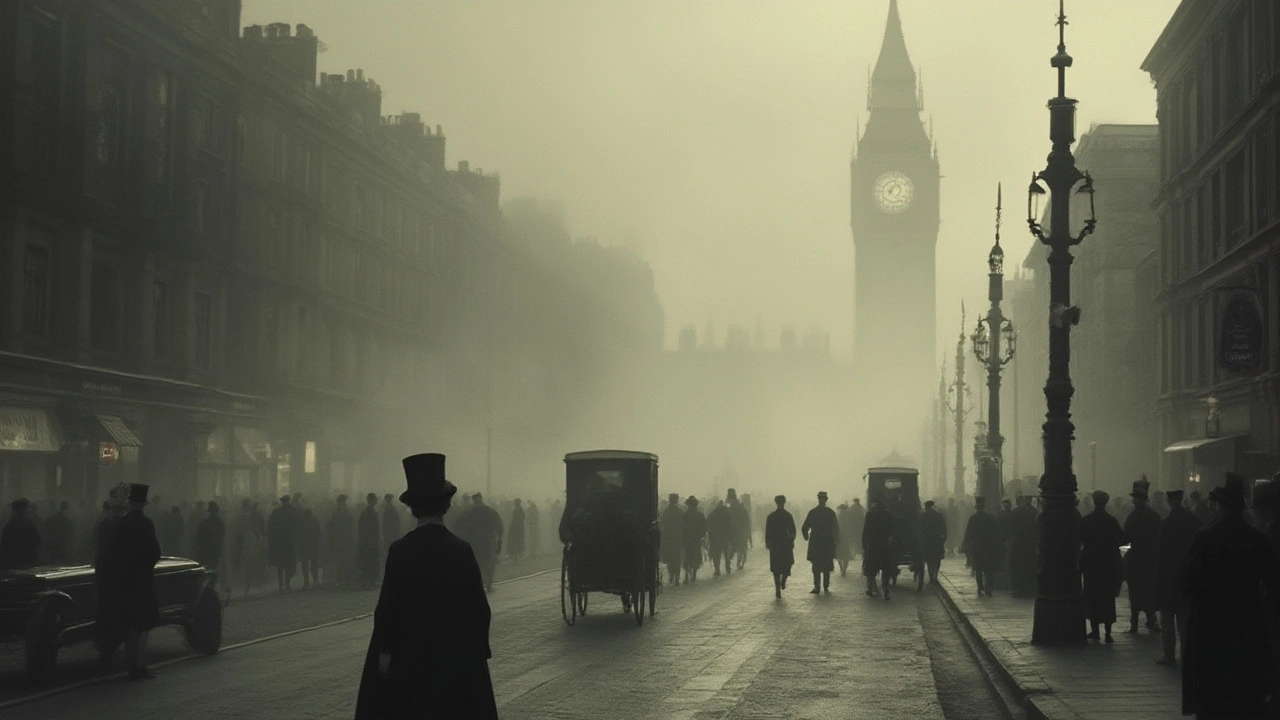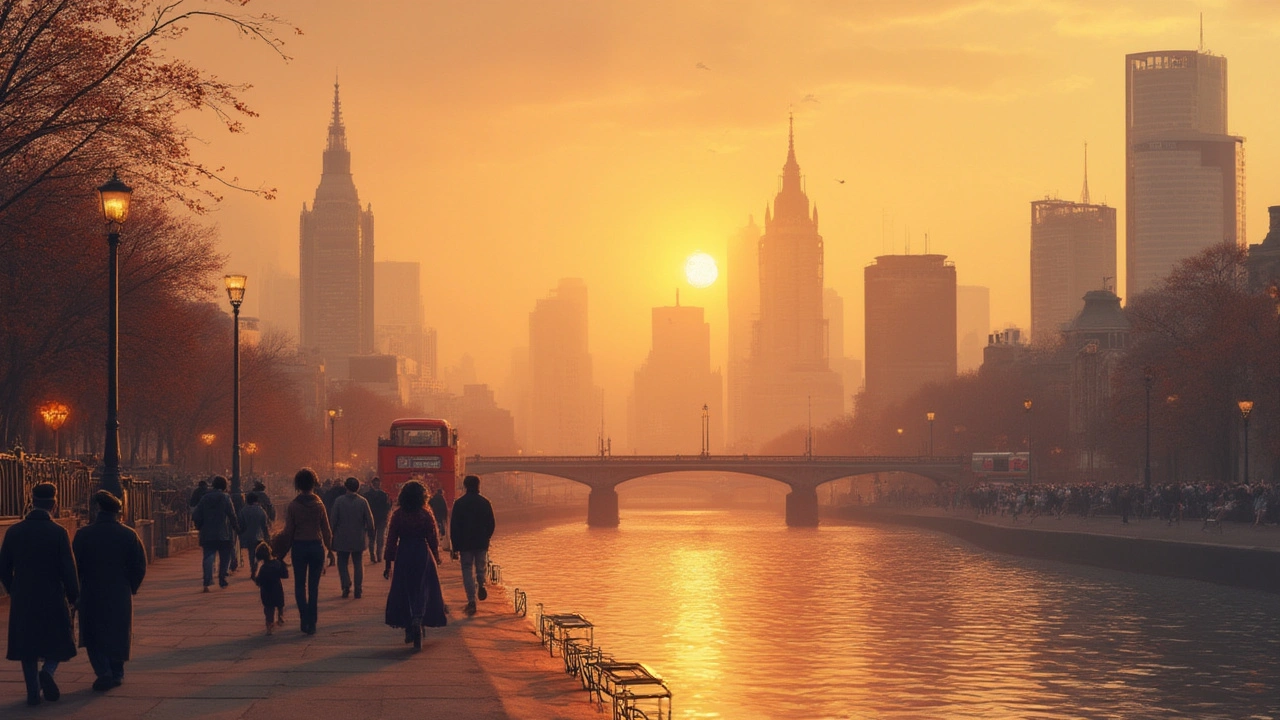
You can't walk down a city street in the UK without crossing someone who’s got an opinion about London. But here’s the thing–the capital is more than red buses and the Queen waving stiffly from a balcony. If you grew up here, or even just visited a few times, you’ve probably heard it called 'The Big Smoke.' Now, that sounds a bit dramatic, doesn’t it? So what’s behind that label, and why does it stick?
Where Did The Big Smoke Nickname Come From?
Back in the day, you couldn’t spend a week in London without coughing your lungs up. We’re talking mid-19th to early 20th century, when coal fires were as common as pigeons in Trafalgar Square. Families heated their homes, factories powered their machines, and everyone puffed and chuffed burny black lumps. This created a constant haze that seeped into your skin and clothes, so thick you couldn’t see down the street. The worst was the 'Great Smog' of 1952, which killed an estimated 12,000 people in a matter of days—that’s more than most small towns.
Before London took on the name 'Big Smoke,' it went by 'the Smoke,' especially from the mouths of working-class Londoners and those heading in from the countryside. But the phrase 'Big Smoke' actually got a push in popularity thanks to outsiders—especially Irish and Australians who’d head to London chasing work or excitement. It was both a name and a warning: if you’re after the big city dream, get ready to be swallowed up by the fog.
Check what the London air used to look like. Old black-and-white photos from the 1900s show people with handkerchiefs and gas masks, groping their way along the Thames. Think pea-soup fog, but with a toxic twist. The smog wasn’t just weather gone wrong—it was pollution, plain and simple. In 1956, the government finally got fed up and passed the Clean Air Act. That started the slow clean-up and led to fewer coal fires and fewer chest-rattles when you walked outdoors.
| Year | London's air quality index | Coal burned per year (million tonnes) | Pop culture nickname use |
|---|---|---|---|
| 1900 | Very Poor | 35 | 'The Smoke' |
| 1952 | Hazardous | 27 | 'The Big Smoke' |
| 1960 | Poor, improving | 12 | 'Big Smoke' (mainstream) |
| 2025 | Moderate | Less than 1 | 'The Big Smoke' (historic, affectionate) |
The Big Smoke nickname stuck. It became a badge of grit but also a running joke. Tourists would ask, 'Why does everyone look like they're late for a funeral?' Locals just shrugged, 'Ah, it’s the Big Smoke, mate.' The city’s identity twined around this nickname, tying history, hardship and a dash of dark London humour together.
How The Smog Changed London’s Culture and City Life
It’s wild to think how something as grim as air pollution could shape a city’s culture. For years, people planned their days around the fog—and the way the smog made everything look surreal. Imagine looking out your window and seeing nothing beyond your own stoop. Crime hid in the haze, and even London's famous black taxis and buses would get lost or wrecked. Students would show up to school late, their stories all about trams creeping along and drivers tying handkerchiefs over their mouths to keep from choking on the yellow-black air.
The city’s poets and novelists took inspiration from the gloom. Charles Dickens wrote of swirling fog in 'Bleak House,' and Sherlock Holmes solved cases in the thick of it. The environment built a whole kind of London mood—one that’s still hanging around in the collective imagination, from gritty detective shows to stylish BBC dramas where it’s always raining.
But living with the smog wasn’t all art and moody literature. It meant fresh fruit and veg spoiled in days, and laundry had to be done inside (or you’d end up with black-speckled sheets). The smog was bad for business, too. Shopkeepers had to sweep the soot off their goods and keep lights burning day and night. That sent electricity bills through the roof—a headache for anyone trying to make a living, not just the big city tycoons.
You can still see hints of the Big Smoke days in London’s architecture. Buildings built before the Clean Air Acts are darker, as if permanent shadows have settled on their stones. Look at St. Paul’s Cathedral or Westminster Abbey, and you’ll spot the difference. Some say it’s character, but anyone who’s had to clean those sooty nooks will tell you otherwise.
Today, the nickname is less a warning and more an inside joke. London air is a hundred times better than it was a century ago, thanks to strict pollution laws and new technology (though we still get those bouts of summer haze or traffic jams around the North Circular). But ask someone from outside the city if they know 'The Big Smoke,' and they’ll almost always say yes—it’s the name that stuck, even if the air doesn’t.

Surprising Facts You Probably Didn't Know About The Big Smoke
Here’s a bit of trivia that might trip up your mates at the pub. Did you know that New York and Toronto have also been called 'The Big Smoke'? Both took the nickname from London, but no other city really lives up to it in the way London does. Statistics from 1952 showed visibility sometimes dropping to less than a metre—a pedestrian could vanish two steps ahead. That’s not poetic license, that’s just fog so thick you could get lost crossing the road to the corner shop.
Another wild bit—the London Underground wasn’t just for getting to work, it became a retreat from the worst of the smog. On those 'pea-souper' days, families and kids would hang out on the platforms, reading the paper or chatting, just to avoid coughing fits outside. It turned the Tube into a real community centre, something you wouldn’t guess from the hurried silence today.
Some of the most famous films about London couldn’t resist using the Big Smoke look. Think of Alfred Hitchcock’s early thrillers, where the fog is almost another character, or the classic image of Jack the Ripper stalking gas-lit alleys. Even video games like Assassin’s Creed Syndicate use the nickname and the vibe for atmosphere—it’s as if the city’s old smog is a selling point for mystery and adventure.
Want another odd one? London’s fog used to be so distinctive it had legal consequences. When insurance companies rewrote policies in the 1940s and 50s, they started including 'smog damage exclusions.' Claiming for 'acts of God' had a whole new meaning when every winter felt like you were breathing in the apocalypse.
Not everything about being The Big Smoke was doom and gloom, though. Some clever Londoners saw business opportunities. Face masks were a popular side hustle, and so-called 'smog masks' (think gas masks but cheaper) turned up in kiosks all over the city. Fashion designers put their own spin on them—leave it to London to invent the smog-chic look decades before the pandemic mask craze.
Tips for Exploring the Big Smoke With Fresh Eyes
If you want to connect with this bit of London’s legacy, you don’t have to imagine yourself choking in a yellow mist. Instead, look for small markers of history as you walk. Take a stroll around the old City, especially in the autumn when the evening air gets a nip. Notice the difference in stonework, where the soot lingers around the windowsills and moss clings on like a shadow that never left. Seek out blue plaques highlighting historic spots—many mark events or places that helped shape the city during its smokiest days.
Pop into the Museum of London or the Science Museum and ask about the smog dioramas—they’re more interesting than you think. The exhibits sometimes get overlooked, but see those Victorian gas masks and newspaper clippings; they give a visceral sense of how bad things got. If you’re with family or friends, challenge them to take old-timey foggy photos on the Embankment at dusk, then compare to the real haze-free view. It’s a little bit of fun that puts things into perspective.
Craving a bite in a classic London atmosphere? Some pubs and restaurants still play on the 'Big Smoke' heritage—look for places with dark wood, old photos, and menus featuring 'smoky' drinks or stews. Ask staff for stories—they always have personal or family tales about blackouts and street lanterns glowing through the night fog.
If you’re up for a walking tour, plenty focus on the history of pollution and the nickname itself. Some even dive into ghost stories, wrapped in the thick atmosphere that once defined London. For early risers, wandering through the city just as it wakes (before the morning traffic hits) can give you an echo of the old days—a chill, misty air that feels a bit magical, minus the coal dust.
To travel like a true Londoner, use the river—not just the Tube. Boats cutting through the Thames offer a different view, especially with the skyline getting clearer every year. You’ll get glimpses of how the city changed—from Titanic-scale piers to modern glass towers—reminding you that The Big Smoke earned its nickname, but no longer has to live up to it.
If you’re hunting for more Big Smoke facts, dig around railway history or have a look at the Met Office’s archive for smog maps. You’ll come away with a new appreciation for just how tough, adaptable, and cheeky Londoners have always been—never mind the weather.